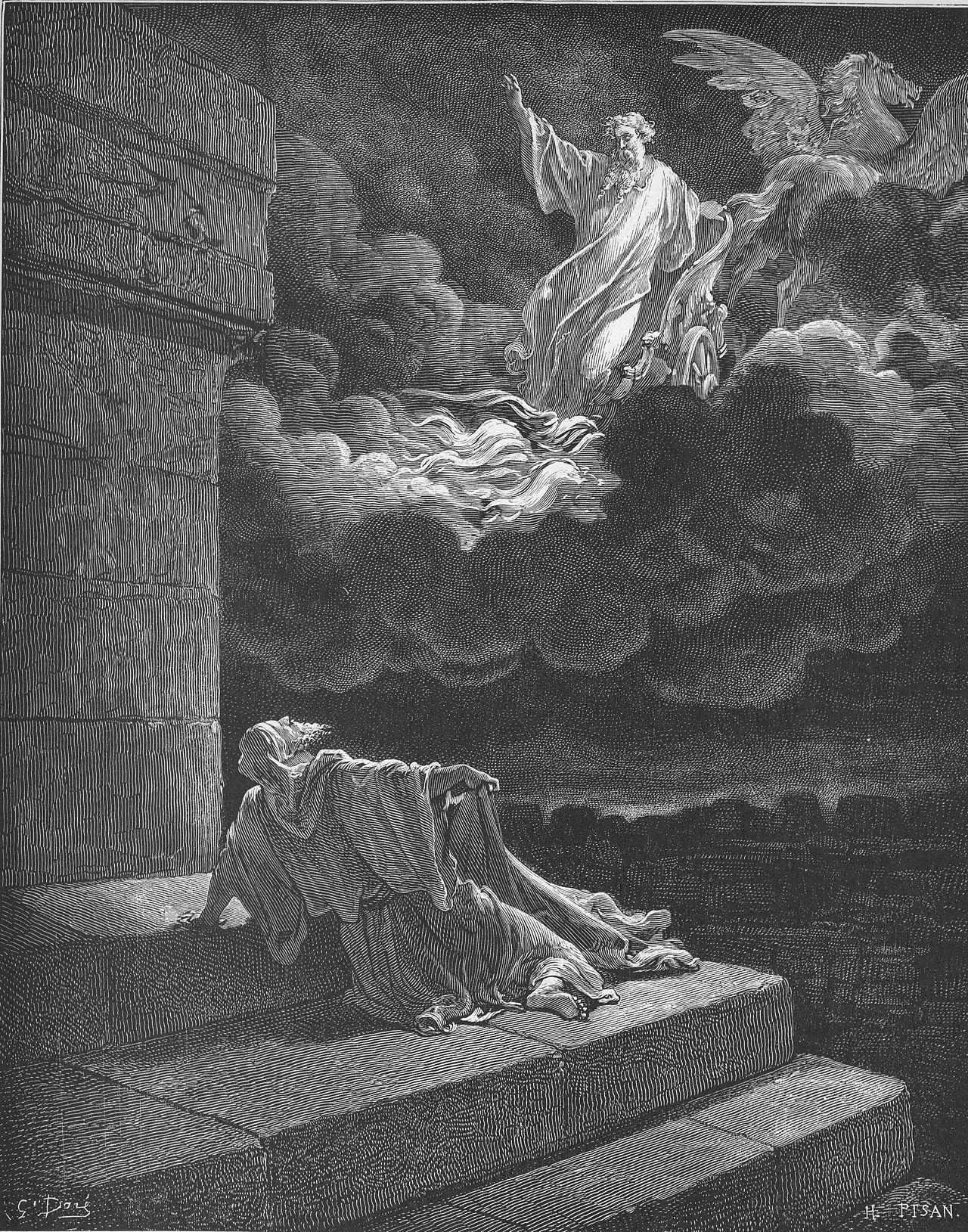It's Saturday, May 11, 2024.
Today’s edition covers criticism of ERLC’s support for the Antisemitism Awareness Act, the ongoing geomagnetic storms, the legend of St. George and the dragon, and much more.
“For the simple are killed by their turning away, and the complacency of fools destroys them; but whoever listens to [wisdom] will dwell secure and will be at ease, without dread of disaster.” (Proverbs 1:32-33)
Of Christian Concern
SOUTHERN BAPTISTS’ RELIGIOUS LIBERTY COMMISSION SUPPORTS A BILL THAT CRITICS SAY VIOLATES RELIGIOUS LIBERTY
Screenshot of Brent Leatherwood at the 2022 SBC Annual Conference.
Brent Leatherwood, president of the Ethics and Religious Liberty Commission (ERLC) of the Southern Baptist Convention (SBC), issued a press release lauding the U.S. House of Representatives’ passage (320-91) of the Antisemitism Awareness Act. The act adopts the definition of antisemitism provided by an intergovernmental agency called the International Holocaust Remembrance Alliance (IHRA). The New York Times reports that that definition is controversial “even among those who have dedicated their careers to studying and combating antisemitism.”
Critics say the definition “pose[s] First Amendment concerns” (Rep. Chip Roy) and could be used to target “orthodox Biblical Christianity” (Al Mohler). Both Christians and Jews have voiced concerns that the act would violate religious liberty and freedom of speech. Some are concerned about allowing an organization that is “unaccountable to the American people” to dictate the legal definition of antisemitism.
Leatherwood and the ERLC, on the other hand, supported the bill: “Approving this bill is the right response, and I would urge the Senate to move forward swiftly.” That statement provoked Southern Baptist pastor David Mitzenmacher to announce that he will be submitting a resolution during the Southern Baptist Convention (SBC) annual meeting (June 11-12 in Indianapolis, Indiana) calling on SBC “entities and their respective leaders” who have supported the bill in their official capacities “to issue public retractions.”
PolitiFact reports, “The bill has moved to the Senate, where its fate is uncertain.” To voice your opinion, find your senator’s information here.
To read the bill for yourself, copy and paste this URL to your web browser: https://www.congress.gov/bill/118th-congress/house-bill/6090/text
Also Noteworthy
Solar flares captured by NASA's Solar Dynamics Observatory (SDO) yesterday and today. (NOAA)
→ A proposed amendment to the SBC constitution would add language to clarify that a church can only be in friendly cooperation with the Convention if it “Affirms, appoints, or employs only men as any kind of pastor or elder as qualified by Scripture.” This “Law Amendment” (so called because it was proposed by Mike Law Jr., pastor of Arlington Baptist Church in Virginia) is an effort to combat liberalism/progressivism in the SBC. See here for a glimpse into a church that the amendment would disfellowship.
→ An attempted shooting of a pastor in a Pennsylvania church last weekend was foiled when the gun failed.
→ Mica Miller, the estranged wife of South Carolina pastor John-Paul Miller, was found dead in a state park last month, where she reportedly committed suicide. Miller’s family and friends have expressed doubt about the suicide, as reports of her husband’s alleged unfaithfulness and abuse have come out. He has been released from his ministerial duties “for a time of healing, counsel, and guidance, pursuant to our governing instrument.”
→ Only 6% of self-identified Christians have a biblical worldview, according to a recent report by George Barna from Arizona Christian University’s Cultural Research Center.
→ Solar flares earlier this week are causing geomagnetic storms across the globe this weekend, resulting in visible Aurora lights “across much of the United States” and “power grid irregularities and degradation to high-frequency communications and GPS.” One observer in Maine told CNN, “It’s one of the most incredible things I’ve ever seen, the awe and wonder.” On the other hand, scientists and others like Bill Nye warn there’s “a real danger to our technological society,” as dependent as we are on electricity and electronics. Is this a beautiful testament to God’s creativity or a fearful threat of His mighty judgment? Or both? The National Oceanic and Atmospheric Administration (NOAA) reports that powerful flares continue to occur, which could result in continuing effects. Aurora may be visible again tonight.
Content Catch-Up
Recent, notable content by Christian creators or of Christian interest.*
Screenshot of Jordan Peterson’s interview on the Shawn Ryan Show. (YouTube / Shawn Ryan Clips)
→ Lyrics Matter: Shane Pruitt, Director of Next Gen Evangelism for the North American Mission Board (NAMB), weighed in on Taylor Swift’s newest album. In an Instagram post, Pruitt exposes the album’s blasphemous lyrics and challenges Christians who they would entertain. (Post)
→ Jordan Peterson’s Beliefs: In a clip from a recent interview, podcaster Shawn Ryan asks famed psychologist and leading public intellectual Jordan Peterson if, after all his studies of the Bible, he believes it. Hear Peterson’s answer. (Video)
→ Analyzing a Typical Joel Osteen Sermon: Internet Bible teacher Mike Winger’s video analyzing an average Joel Osteen sermon, which was taken down from YouTube on a copyright claim from Osteen’s church two years ago, is now available on X. (Post/Video)
*Not necessarily an endorsement
Church History Tidbit
St. George and the Dragon
St. George depicted in the Nuremberg Chronicle of 1493. (Public Domain)
St. George is a famous saint with numerous patronages worldwide. The historical figure is shrouded in legend, but he was ostensibly a Roman soldier who became an early Christian martyr around AD 303 in the Diocletianic Persecution.
The earliest records of his purported sufferings and martyrdom date to the 5th century. However, the most famous legend associated with St. George dates back only to the 11th century, the Middle Ages. It tells of how he saves a princess from a dragon. Some scholars believe this story emerged as a synthesis of “Christian representations” of good conquering evil, the “Iranian motif of a hero battling a dragon,” and “the language of Byzantine hagiography.”
In the story, a city called Lasia is terrorized by a dragon from a nearby lake. At the king’s suggestion, the people offer their children to appease the beast. When it comes time for the king to offer his only daughter, he tries to bribe the people to let her live, but they refuse. At that time, George arrives and stops at the lake to water his horse, where he finds the weeping maiden and the city gathered to watch her demise. After hearing of her predicament and the city’s paganism, George prays that God would make the beast submit to him. A voice from heaven grants his request, and he subdues the dragon, tying it with the maiden’s belt. Once the people promise to convert to Christianity, he kills the dragon.
St. George’s reputation captured the imaginations of the Crusaders in the Middle Ages. They reportedly believed that George fought with them and was “the first to mount the scaling ladders” in the attack on Jerusalem in the First Crusade.
As for the actual George, his actions, to adapt the words of Gelasius I, “are known better to God than to human beings.”
Learn more and read a translation of the earliest text here.
CITE YOUR SOURCES: The citation was missing last week, but the source for the information in the “Church History Tidbit” on John Wycliffe was Justo L. González’s The Story of Christianity: Volume 1, pp. 411-415.
The Bible, Briefly
The Sons of the Prophets (Part 2)

Elijah Ascends to Heaven in a Chariot of Fire, after which the sons of the prophets sent fifty men to look for him on nearby mountains and valleys. (Gustave Doré, 1866, Public Domain)
Scripture sometimes mentions groups of prophets and “sons of the prophets.” What’s the deal with these groups, and what can their biblical appearances teach us about Old Testament prophesying? Last week, we observed the first references to them. Now, we’ll consider how many there were.
How Many Were There?
There was at least one group during Samuel’s lifetime. Last week, we saw that 1 Samuel refers to a group of prophets at or near Bethel (10:5-13) and, later, a company of prophets in Ramah (19:18-24). These may be the same group (the prophets from Ramah could have been visiting the place of worship at Bethel), but it’s unclear. Either way, the judge, priest, and prophet Samuel was head of the group in Ramah (19:20), and almost certainly its founder—Ramah, after all, was his hometown (7:17).
Whether more than one group existed during Samuel’s lifetime, multiple groups appear later in the biblical text. How many groups and how many prophets were in a group? While the prophets in Samuel’s day are not numbered, we are given some figures moving forward. As Old Testament scholar Ira M. Price notes in his 1889 article:*
Evidence suggests that, eventually, groups of prophets existed in at least six different locales: Ramah, Bethel, Gilgal, Jericho, Carmel, and Samaria.
Some generations after Samuel, one hundred prophets are hidden in a cave to escape the wicked queen Jezebel (1 Kings 18:4).
Not long after that, around 400 prophets (probably from Samaria) gathered to advise the king (1 Kings 22:6). (Of course, these prophets turned out to have a lying spirit [1 Kings 22:19-23], which would make them false prophets.)
Before Elijah was taken to heaven, “Fifty men of the sons of the prophets” from Jericho followed him and his protégé Elisha toward the Jordan “and stood at some distance from them.”
After Elijah was taken up, “the sons of the prophets” sent a group of “fifty strong men” to look for him in case God had “cast him upon some mountain or into some valley” (2 Kings 2:16).
Later, in 2 Kings 4:43, the number of prophets with Elisha at Gilgal is one hundred—whom he miraculously feeds with only 20 loaves of bread and some grain, with some left over (sound familiar?).
At one point, the sons of the prophets in Jericho outgrew the place where they dwelled under Elisha’s charge (2 Kings 6:1).
These observations highlight that the number of these prophets and sons of prophets was not insignificant. With wives and children in the mix (e.g., 2 Kings 4:1), these communities or sub-communities were undoubtedly, at times, rather substantial. Even so, the sons of the prophets in a particular place would apparently eat together (2 Kings 4:42-44), so they were presumably tight-knit groups.
To be continued…
__________________
*Ira M. Price, “The Schools of the Sons of the Prophets,” The Old Testament Student 8, no. 7 (1889): 244–49. http://www.jstor.org/stable/3156528.
What did you think of today’s briefing?
Know someone who would enjoy this?Please SHARE this newsletter
Have some feedback for me? Reply to this email with comments or suggestions. I’d love to hear from you!
Why "18:15"? The name Project 18:15 is based on Proverbs 18:15: “An intelligent heart acquires knowledge, and the ear of the wise seeks knowledge.” The aim is for this weekly email—a Christian news briefing, a Bible study, and a Church history lesson rolled into one—to be one way you keep abreast of current events and acquire knowledge you might not acquire elsewhere.
Unless otherwise indicated, all Scripture quotations are from The ESV® Bible (The Holy Bible, English Standard Version®), copyright © 2001 by Crossway, a publishing ministry of Good News Publishers. Used by permission. All rights reserved.
Copyright (C) " target="_blank">unsubscribe.
